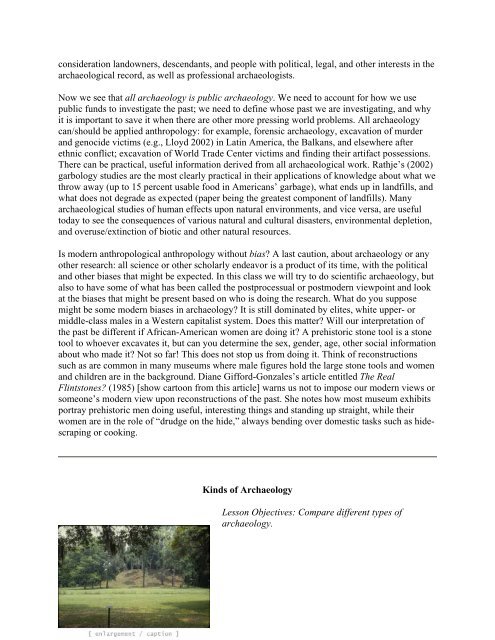INTRODUCTION TO ARCHAEOLOGY Nancy White - Touro Institute
INTRODUCTION TO ARCHAEOLOGY Nancy White - Touro Institute
INTRODUCTION TO ARCHAEOLOGY Nancy White - Touro Institute
You also want an ePaper? Increase the reach of your titles
YUMPU automatically turns print PDFs into web optimized ePapers that Google loves.
consideration landowners, descendants, and people with political, legal, and other interests in the<br />
archaeological record, as well as professional archaeologists.<br />
Now we see that all archaeology is public archaeology. We need to account for how we use<br />
public funds to investigate the past; we need to define whose past we are investigating, and why<br />
it is important to save it when there are other more pressing world problems. All archaeology<br />
can/should be applied anthropology: for example, forensic archaeology, excavation of murder<br />
and genocide victims (e.g., Lloyd 2002) in Latin America, the Balkans, and elsewhere after<br />
ethnic conflict; excavation of World Trade Center victims and finding their artifact possessions.<br />
There can be practical, useful information derived from all archaeological work. Rathje’s (2002)<br />
garbology studies are the most clearly practical in their applications of knowledge about what we<br />
throw away (up to 15 percent usable food in Americans’ garbage), what ends up in landfills, and<br />
what does not degrade as expected (paper being the greatest component of landfills). Many<br />
archaeological studies of human effects upon natural environments, and vice versa, are useful<br />
today to see the consequences of various natural and cultural disasters, environmental depletion,<br />
and overuse/extinction of biotic and other natural resources.<br />
Is modern anthropological anthropology without bias? A last caution, about archaeology or any<br />
other research: all science or other scholarly endeavor is a product of its time, with the political<br />
and other biases that might be expected. In this class we will try to do scientific archaeology, but<br />
also to have some of what has been called the postprocessual or postmodern viewpoint and look<br />
at the biases that might be present based on who is doing the research. What do you suppose<br />
might be some modern biases in archaeology? It is still dominated by elites, white upper- or<br />
middle-class males in a Western capitalist system. Does this matter? Will our interpretation of<br />
the past be different if African-American women are doing it? A prehistoric stone tool is a stone<br />
tool to whoever excavates it, but can you determine the sex, gender, age, other social information<br />
about who made it? Not so far! This does not stop us from doing it. Think of reconstructions<br />
such as are common in many museums where male figures hold the large stone tools and women<br />
and children are in the background. Diane Gifford-Gonzales’s article entitled The Real<br />
Flintstones? (1985) [show cartoon from this article] warns us not to impose our modern views or<br />
someone’s modern view upon reconstructions of the past. She notes how most museum exhibits<br />
portray prehistoric men doing useful, interesting things and standing up straight, while their<br />
women are in the role of “drudge on the hide,” always bending over domestic tasks such as hidescraping<br />
or cooking.<br />
Kinds of Archaeology<br />
Lesson Objectives: Compare different types of<br />
archaeology.
















